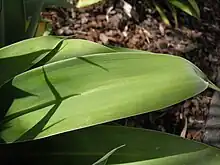Arthropodium cirratum
Arthropodium cirratum (rengarenga, renga lily, New Zealand rock lily, rengarenga, or maikaika) is a species of herbaceous perennial plant, endemic to New Zealand, where it may once have been farmed. It is used for medicine as well as food, and has symbolic importance in traditional Māori culture.[4]
| Arthropodium cirratum | |
|---|---|
 | |
| Scientific classification | |
| Kingdom: | Plantae |
| Clade: | Tracheophytes |
| Clade: | Angiosperms |
| Clade: | Monocots |
| Order: | Asparagales |
| Family: | Asparagaceae |
| Subfamily: | Lomandroideae |
| Genus: | Arthropodium |
| Species: | A. cirratum |
| Binomial name | |
| Arthropodium cirratum | |
| Synonyms[3] | |
|
Anthericum cirratum G.Forst. | |
The Māori name rengarenga is a reduplication of Proto-Polynesian *renga which in other related languages corresponds to turmeric, especially its powdered form (see Samoan: lega, Hawaiian: lena); this association is due to both plants' similar stem and root characteristics.[5]
Description
The leaves are 30–60 cm (12–24 in) long and 3–10 cm (1.2–3.9 in) wide. The flower stalk often reaches one metre, and bears many white six-petalled flowers, in groups of two or three, each about 2 cm (0.8 in) across. The stamens are tricoloured - purple and white, with yellow at the curled end. The roots are 2–3 cm (0.8–1.2 in) wide.
.jpg.webp)

Taxonomy
It was first described in 1786 as Anthericum cirrhatum by Georg Forster.[6] In 1822, Robert Brown assigned it to the genus, Arthropodium, resulting in the name, Arthropodium cirrhatum (now A. cirratum.)[1][2]
Distribution and habitat
It occurs naturally north of Greymouth and Kaikōura near the sea and, as the name suggests, usually on rocks.[4]
Cultivation and uses
It is often grown as an ornamental plant. The rhizomes are edible when cooked and can be found throughout the year. The rhizomes were once eaten by the Māori after being cooked in a hāngi. William Colenso believed, for two reasons, that this plant was once cultivated by them: firstly, the plant grows much larger under cultivation than it usually does in the wild; and secondly it was often found near old deserted Māori homes and plantations. However, he lists it as only fourteenth in importance, in his list of eighteen kinds of wild vegetable food used by the Māori.[4]
References
- "Arthropodium cirratum". International Plant Names Index (IPNI). Royal Botanic Gardens, Kew; Harvard University Herbaria & Libraries; Australian National Botanic Gardens.
- Brown, R. (1822) Bot. Mag. 49: t. 2350
- "Anthericum latifolium Banks & Sol. ex Kunth. | Plants of the World Online | Kew Science". Plants of the World Online. Retrieved 24 November 2019.
- Crowe, A. (2004). A Field Guide to the Native Edible Plants of New Zealand. Penguin Books. Penguin Group (NZ) cnr Airborne and Rosedale Roads, Albany, Auckland 1310, New Zealand.
- "Rengarenga". Te Māra Reo. Benson Family Trust. 2022. Retrieved 30 October 2022.
- Forster, G. (1786) Florulae Insularum Australium Prodromus n. 148